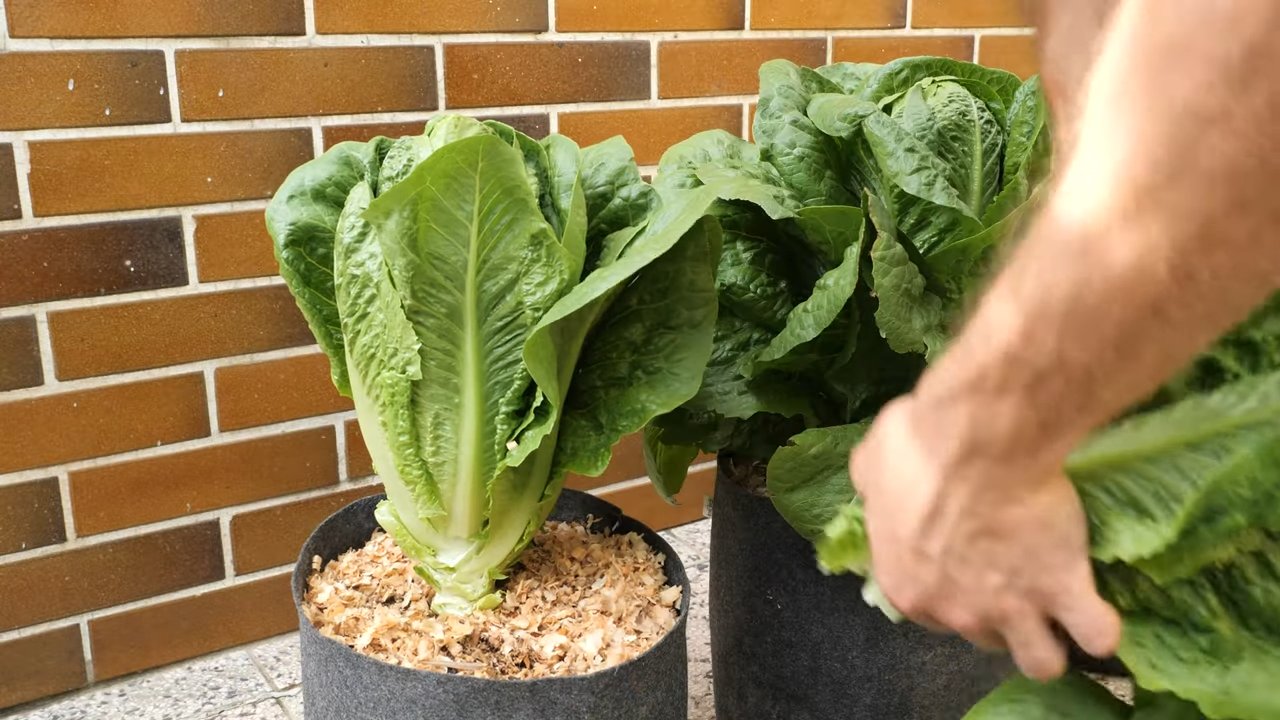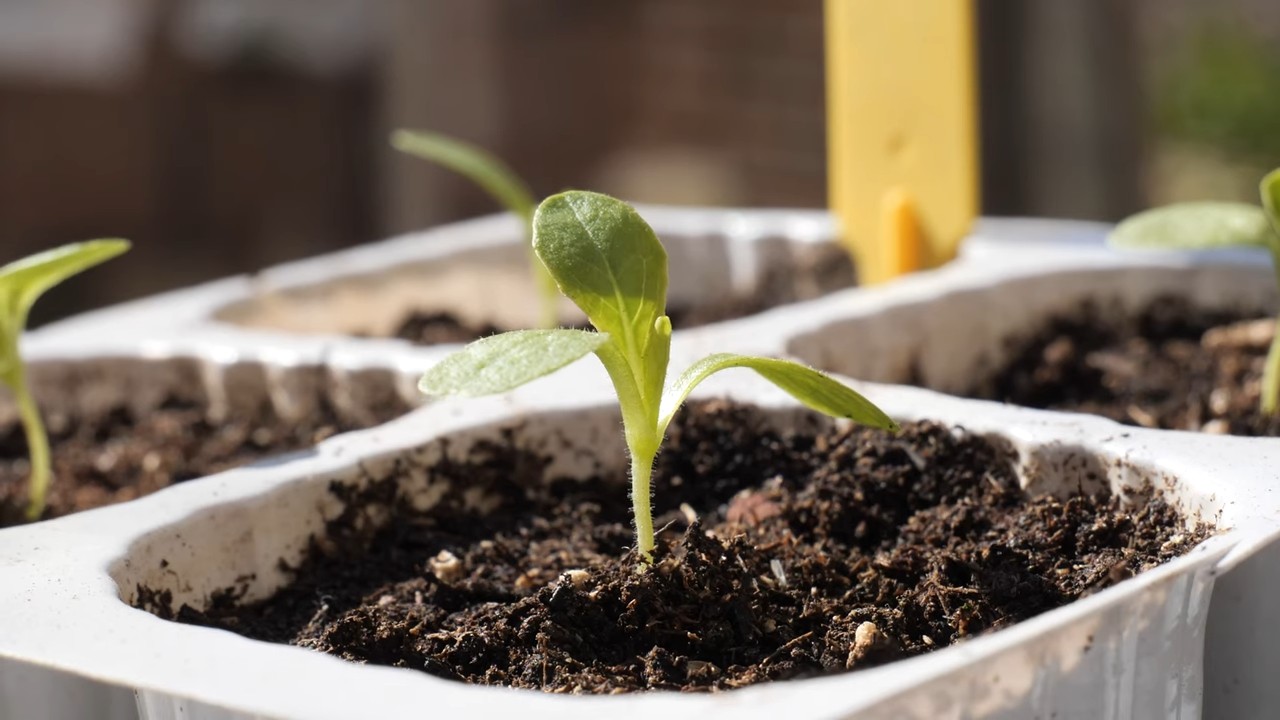Grow Romaine Lettuce Easily, even if you think you have a black thumb! Have you ever dreamed of stepping outside your back door and snipping fresh, crisp Romaine lettuce for a vibrant salad? I know I have! Forget those limp, overpriced heads at the grocery store. This isn’t just about saving money; it’s about connecting with nature and enjoying the unparalleled flavor of homegrown goodness.
Cultivating your own food, even something as simple as lettuce, has deep roots. From ancient Roman gardens to the victory gardens of World War II, growing your own produce has always been a symbol of self-sufficiency and resilience. But let’s be honest, sometimes it feels intimidating, right? That’s where these easy DIY tricks come in!
In this article, I’m going to share my favorite, foolproof methods to grow Romaine lettuce easily, regardless of your gardening experience or space constraints. Whether you have a sprawling backyard or just a sunny windowsill, I’ll show you how to enjoy a continuous supply of delicious, healthy lettuce. Say goodbye to store-bought lettuce and hello to fresh, flavorful salads all season long! These hacks will save you time, money, and frustration, allowing you to enjoy the rewarding experience of growing your own food. Let’s get started!

Grow Your Own Romaine Lettuce: A Beginner’s Guide
Hey there, fellow gardening enthusiasts! I’m so excited to share my foolproof method for growing crisp, delicious romaine lettuce right in your own backyard (or even on your balcony!). Forget those sad, wilted heads at the grocery store – fresh, homegrown romaine is a game-changer. This guide will walk you through every step, from seed to salad. Let’s get started!
Choosing Your Romaine Variety
First things first, let’s talk romaine varieties. There are tons to choose from, each with slightly different characteristics. Here are a few of my favorites:
* ‘Paris Island Cos’: This is a classic, reliable variety with upright, tightly packed heads. It’s known for its excellent flavor and resistance to bolting (going to seed prematurely).
* ‘Little Gem’: A smaller, more compact romaine, perfect for smaller gardens or containers. It’s incredibly tender and sweet.
* ‘Red Romaine’: Adds a pop of color to your garden and your salads! The flavor is similar to green romaine, but with a slightly nuttier taste.
* ‘Valmaine’: Another great option for hot weather, as it’s slow to bolt. It produces large, sturdy heads.
Consider your climate and space when making your choice. If you’re in a hot climate, look for bolt-resistant varieties. If you have limited space, ‘Little Gem’ might be the perfect fit.
Getting Started: Sowing Your Seeds
You have two main options for starting your romaine: direct sowing or starting seeds indoors. I personally prefer starting seeds indoors, as it gives me a head start and protects the delicate seedlings from pests and harsh weather.
Starting Seeds Indoors:
* Timing is Key: Start your seeds about 4-6 weeks before the last expected frost in your area. This will give them plenty of time to develop before transplanting them outdoors.
* Gather Your Supplies: You’ll need seed starting trays or small pots, seed starting mix (a light, sterile soil mix), romaine lettuce seeds, a spray bottle, and a grow light (optional, but highly recommended).
* Sowing the Seeds: Fill your seed starting trays or pots with seed starting mix. Moisten the soil gently with a spray bottle. Sow 2-3 seeds per cell or pot, about ¼ inch deep.
* Providing the Right Conditions: Cover the trays or pots with a clear plastic dome or plastic wrap to create a humid environment. Place them in a warm location (around 70°F/21°C). Once the seeds germinate (usually within 7-10 days), remove the cover and place them under a grow light or in a sunny window.
* Watering and Thinning: Keep the soil consistently moist, but not soggy. Once the seedlings have their first true leaves (the second set of leaves), thin them to one seedling per cell or pot. Snip off the weaker seedlings at the soil line with scissors.
Direct Sowing:
* Wait for Warmer Weather: Direct sowing is best done when the soil has warmed up to at least 50°F (10°C).
* Prepare the Soil: Choose a sunny spot in your garden with well-drained soil. Amend the soil with compost or other organic matter to improve its fertility and drainage.
* Sowing the Seeds: Sow the seeds about ¼ inch deep and ½ inch apart in rows.
* Watering and Thinning: Keep the soil consistently moist until the seeds germinate. Once the seedlings are a few inches tall, thin them to about 6-8 inches apart.
Transplanting Your Seedlings (If You Started Indoors)
Once your seedlings have developed several sets of true leaves and the weather has warmed up, it’s time to transplant them outdoors.
1. Harden Off Your Seedlings: This is a crucial step to acclimate your seedlings to the outdoor environment. Gradually expose them to longer periods of outdoor sunlight and cooler temperatures over the course of a week. Start by placing them in a sheltered spot for an hour or two each day, gradually increasing the time and exposure.
2. Prepare the Planting Bed: Choose a sunny spot in your garden with well-drained soil. Amend the soil with compost or other organic matter.
3. Transplant Carefully: Dig holes that are slightly larger than the root balls of your seedlings. Gently remove the seedlings from their trays or pots and place them in the holes. Backfill with soil and water thoroughly. Space the seedlings about 6-8 inches apart.
Caring for Your Romaine Lettuce
Now that your romaine is planted, it’s time to provide it with the care it needs to thrive.
* Watering: Romaine lettuce needs consistent moisture to grow well. Water deeply whenever the top inch of soil feels dry. Avoid overhead watering, as this can lead to fungal diseases. Drip irrigation or soaker hoses are ideal.
* Fertilizing: Romaine lettuce is a heavy feeder, so it benefits from regular fertilization. Use a balanced organic fertilizer according to the package directions. You can also side-dress with compost or worm castings.
* Weeding: Keep the area around your romaine lettuce free of weeds, as they can compete for nutrients and water. Hand-pull weeds carefully to avoid disturbing the roots of your lettuce.
* Pest Control: Keep an eye out for common lettuce pests, such as aphids, slugs, and snails. You can control aphids with a strong spray of water or insecticidal soap. Use slug and snail bait or traps to control these pests.
* Sunlight: Romaine lettuce needs at least 6 hours of sunlight per day. However, in hot climates, it can benefit from some afternoon shade.
* Mulching: Apply a layer of mulch around your romaine lettuce to help retain moisture, suppress weeds, and regulate soil temperature. Straw, shredded leaves, or wood chips are all good options.
Harvesting Your Romaine Lettuce
The best part! You can start harvesting your romaine lettuce when the heads are about 6-8 inches tall.
1. Harvesting Individual Leaves: For a continuous harvest, you can harvest individual outer leaves as needed. Simply snap or cut them off at the base of the plant.
2. Harvesting the Entire Head: To harvest the entire head, use a sharp knife to cut it off at the base of the plant.
3. Timing is Important: Harvest your romaine lettuce in the morning, when the leaves are crisp and cool. Avoid harvesting during the heat of the day, as the leaves will be more likely to wilt.
4. Succession Planting: To ensure a continuous supply of romaine lettuce throughout the growing season, plant new seeds or seedlings every few weeks. This is called succession planting.
Troubleshooting Common Problems
Even with the best care, you may encounter some problems when growing romaine lettuce. Here are a few common issues and how to address them:
* Bolting (Going to Seed): This happens when lettuce is exposed to hot weather or stress. The plant will send up a flower stalk and the leaves will become bitter. To prevent bolting, choose bolt-resistant varieties, provide shade during hot weather, and water regularly. If your lettuce does bolt, you can still harvest the leaves, but they may not taste as good.
* Aphids: These tiny pests can suck the sap from your lettuce leaves, causing them to become distorted and yellow. Control aphids with a strong spray of water or insecticidal soap.
* Slugs and Snails: These pests can chew holes in your lettuce leaves. Use slug and snail bait or traps to control them. You can also try hand-picking them off the plants at night.
* Downy Mildew: This fungal disease can cause yellow spots on the upper surface of the leaves and a white, fuzzy growth on the underside. To prevent downy mildew, provide good air circulation, avoid overhead watering, and use a fungicide if necessary.
* Tipburn: This condition causes the edges of the lettuce leaves to turn brown and die. It’s usually caused by calcium deficiency or inconsistent watering. To prevent tipburn, amend the soil with calcium-rich amendments like bone meal or lime, and water regularly.
Enjoying Your Homegrown Romaine
Now that you’ve harvested your delicious romaine lettuce, it’s time to enjoy it! Here are a few ideas:
* Salads: Romaine lettuce is the perfect base for a classic Caesar salad or any other type of salad.
* Wraps: Use romaine lettuce leaves as wraps for tacos, sandwiches, or other fillings.
* Grilled Romaine: Brush romaine lettuce halves with olive oil and grill them for a smoky, flavorful side dish.
* Smoothies: Add a few romaine lettuce leaves to your smoothies for a boost of vitamins and minerals.
Growing your own romaine lettuce is a rewarding experience that will provide you with fresh, delicious greens all season long. With a little bit of care and attention, you can enjoy the taste of homegrown romaine

Conclusion
So, there you have it! Growing your own romaine lettuce from kitchen scraps isn’t just a fun experiment; it’s a sustainable, cost-effective, and incredibly rewarding way to enjoy fresh, crisp lettuce right from your own home. Forget those wilted, overpriced heads at the grocery store. With a little patience and minimal effort, you can transform those seemingly useless romaine lettuce ends into a thriving source of salad greens.
Why is this DIY trick a must-try? Because it’s more than just a gardening hack; it’s a step towards reducing food waste, connecting with nature, and enjoying the unparalleled flavor of homegrown produce. Imagine the satisfaction of tossing a salad made entirely from lettuce you nurtured yourself. It’s a feeling that store-bought lettuce simply can’t replicate.
But the benefits don’t stop there. Growing romaine lettuce this way is incredibly space-efficient, making it perfect for apartment dwellers or anyone with limited gardening space. A sunny windowsill or a small balcony is all you need to get started. Plus, it’s a fantastic educational opportunity for kids, teaching them about plant life cycles and the importance of sustainability.
Looking for variations? Absolutely! Once you’ve mastered the basic technique, experiment with different types of lettuce. Try regrowing butter lettuce, iceberg lettuce, or even bok choy. You can also explore different growing mediums. While water propagation is a great starting point, consider transplanting your regrown romaine lettuce into a pot filled with nutrient-rich soil for even more robust growth. Add some organic fertilizer to the soil to give your lettuce an extra boost. You can also try hydroponics for a completely soil-free growing experience.
Another fun variation is to experiment with different light conditions. While romaine lettuce thrives in bright, indirect sunlight, you can also try using grow lights to supplement natural light, especially during the darker winter months. This will ensure that your lettuce continues to grow even when the days are short.
Don’t be afraid to get creative with your setup. Use recycled containers, decorate your pots, and create a mini-garden that reflects your personal style. The possibilities are endless!
We wholeheartedly encourage you to give this DIY trick a try. It’s a simple, yet impactful way to make a positive change in your life and the environment. And most importantly, don’t forget to share your experience with us! We’d love to see your regrown romaine lettuce thriving in your homes. Share your photos, tips, and stories on social media using #GrowRomaineLettuceEasily. Let’s inspire others to join the movement and embrace the joy of homegrown goodness. Happy growing!
Frequently Asked Questions (FAQ)
1. How long does it take to regrow romaine lettuce from a base?
The time it takes to regrow romaine lettuce from a base can vary depending on several factors, including the amount of sunlight, water quality, and temperature. Generally, you can expect to see new growth within a few days of placing the base in water. Within 1-2 weeks, you should have a noticeable amount of new leaves. It will take approximately 3-4 weeks to grow a substantial amount of lettuce that is ready to harvest. Remember to change the water every 1-2 days to prevent bacterial growth and ensure optimal growth.
2. What is the best way to ensure my romaine lettuce regrows successfully?
To maximize your chances of success when regrowing romaine lettuce, follow these tips:
* **Choose a healthy base:** Select a romaine lettuce base that is firm, crisp, and free from any signs of rot or decay.
* **Provide adequate sunlight:** Romaine lettuce needs at least 6 hours of sunlight per day. Place your lettuce in a sunny windowsill or under grow lights.
* **Change the water regularly:** Refresh the water every 1-2 days to prevent bacterial growth and provide fresh nutrients to the lettuce.
* **Consider transplanting to soil:** Once the lettuce has developed a good root system, transplant it to a pot filled with well-draining soil for more robust growth.
* **Fertilize regularly:** If you transplant to soil, fertilize your lettuce every 2-3 weeks with a balanced organic fertilizer.
3. Can I regrow romaine lettuce indefinitely?
While you can regrow romaine lettuce multiple times from the same base, the quality and yield will typically decrease with each subsequent regrowth. After a few cycles, the lettuce may become less flavorful and produce fewer leaves. For best results, it’s recommended to start with a fresh base every few cycles. You can also try saving seeds from your regrown lettuce to start new plants from scratch.
4. What are some common problems when regrowing romaine lettuce and how can I fix them?
Some common problems you might encounter when regrowing romaine lettuce include:
* **Rotting:** This is usually caused by stagnant water or bacterial growth. Change the water regularly and ensure good air circulation.
* **Yellowing leaves:** This can be a sign of nutrient deficiency or lack of sunlight. Transplant the lettuce to soil and fertilize regularly, or provide more sunlight.
* **Slow growth:** This can be due to insufficient sunlight, poor water quality, or lack of nutrients. Ensure the lettuce is getting enough sunlight, change the water regularly, and consider fertilizing.
* **Pests:** While less common indoors, pests like aphids can sometimes infest regrown lettuce. Inspect your lettuce regularly and treat any infestations with organic pest control methods.
5. Is regrown romaine lettuce as nutritious as store-bought lettuce?
Regrown romaine lettuce can be just as nutritious as store-bought lettuce, provided it is grown in optimal conditions. The nutrient content will depend on factors such as the quality of the water, the amount of sunlight, and the type of fertilizer used (if any). To ensure your regrown lettuce is as nutritious as possible, provide it with plenty of sunlight, fresh water, and consider transplanting it to nutrient-rich soil and fertilizing regularly.
6. Can I use tap water to regrow romaine lettuce?
While you can use tap water to regrow romaine lettuce, it’s best to use filtered or dechlorinated water. Tap water often contains chlorine and other chemicals that can inhibit plant growth. If you must use tap water, let it sit out for 24 hours to allow the chlorine to evaporate before using it.
7. How do I harvest my regrown romaine lettuce?
You can harvest your regrown romaine lettuce by simply cutting off the outer leaves as needed, leaving the inner leaves to continue growing. This is known as the “cut-and-come-again” method. Alternatively, you can harvest the entire head of lettuce at once. To do this, simply cut the lettuce at the base, leaving about an inch of the stem intact. The base may continue to produce new growth, allowing you to harvest multiple times.
8. Can I grow romaine lettuce indoors year-round?
Yes, you can grow romaine lettuce indoors year-round, provided you provide it with adequate sunlight or artificial light. During the winter months, you may need to supplement natural light with grow lights to ensure the lettuce gets enough light to thrive.
9. What other vegetables can I regrow from scraps?
Besides romaine lettuce, many other vegetables can be regrown from scraps, including celery, green onions, carrots (for the greens), basil, and ginger. Experiment with different vegetables and see what you can grow!
10. How does growing romaine lettuce easily from scraps contribute to sustainability?
Growing romaine lettuce easily from scraps is a fantastic way to promote sustainability. It reduces food waste by utilizing parts of the lettuce that would otherwise be discarded. It also reduces the need to purchase lettuce from the store, which in turn reduces the carbon footprint associated with transportation and packaging. Furthermore, it encourages a more localized and sustainable food system, empowering individuals to grow their own food and connect with nature.




Leave a Comment